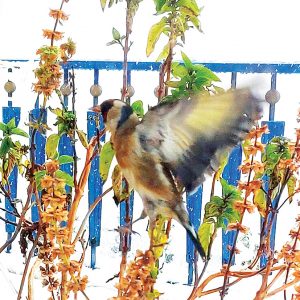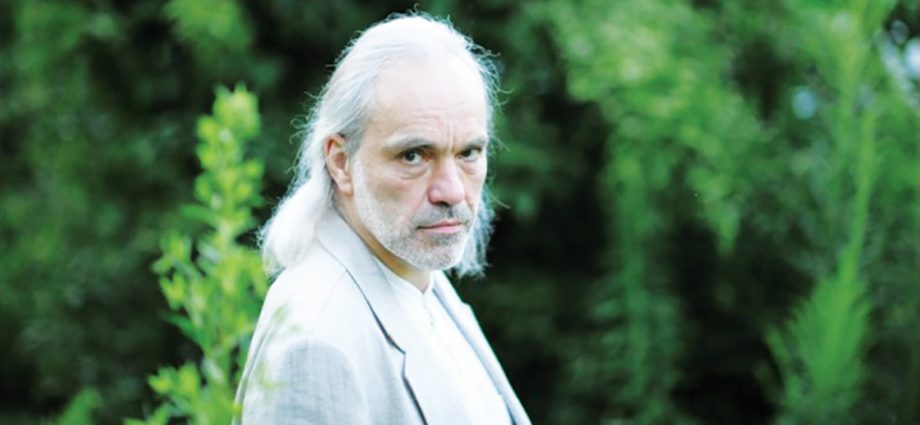The example of “The Nightingale” by Latvian composer Uģis Prauliņš (*1957)
 Mr Prauliņš, you compose for instrumental ensemble as well as for choirs, and nature is always on your mind. To what extent does nature inspire your work?
Mr Prauliņš, you compose for instrumental ensemble as well as for choirs, and nature is always on your mind. To what extent does nature inspire your work?
Always, permanently. For years, I have always had impressions and visions from nature in my mind while creating. There are even sections of my work which conjure up, in my mind, certain places, a tree, a certain environment: there is always that image in my head. I started to feel strongly about nature early in my childhood in the countryside: the sunlight through the canopies of the trees, the paths under the trees, the rainy days and the dew in the lush grass and the fallen leaves in gold and various colours. Later in my childhood I learned about the sea, the winds, the sand, the unusual vegetation, piercy pine needles, heat … singing birds and fresh streams of air in the morning when opening doors.
These childhood memories are really essential for me, they are like a foundation to my life. In later years, I saw the parks in Riga, the graveyards, especially the old abandoned cemetery: it sounded to me like Black Sabbath I (the very first album of this metal group), the forests sounded like Jethro Tull and a bit like Gentle Giant (both British rock bands). Pink Floyd is associated, for me, with the sunrise in the dewy countryside. Arvo Pärt, in later years, is for me linked to the grey (misty) and (placid) sandy coasts of the Baltic Sea.
In 2012, you composed “The Nightingale” for recorder, mixed choir and speaker. The recording with Stephen Layton and the Danish National Vocal Ensemble was nominated for two Grammy awards (“Best Choral Performance” and “Best Contemporary Composition”). What is the story of this piece?
As early as in the early 1990s, when gigging in Denmark, I heard a recording of the young recorder virtuoso Michala Petri – which was breathtaking … I had the dream of composing for her (but, of course, that’s one of those dreams you will never reach and fulfil). At that time I also encountered the sound, the symphony of sounds and contemplative (and windy!) moods from Denmark.
Fifteen years later, while representing the Latvian Composers’ Union in MIDEM, Cannes, I met lute player, guitarist and music producer Lars Hannibal (OUR Recordings), who – after we kept meeting each year at MIDEM – eventually suggested I create a large piece for wonderful genius Michala Petri. My first thought was for recorder and chamber orchestra, however (and wisely) the choice as to accompaniment fell to the choir. It would be a unique line-up. At that time, Maestro Stephen Layton, who visited me in Riga, was also the conductor of the Danish Radio Choir/Danish National Vocal Ensemble. We all agreed on such a concept. At that time, we already knew what the subject was going to be. Lars Hannibal had already suggested Hans Christian Andersen, whose 200th anniversary was being celebrated, and the fairy-tale about the Nightingale – and Michala Petri is definitely the nightingale from Denmark in the wide world! Thus, after presentations to Danish radio, the radio company commissioned the piece and set the date for the premiere(s) in Århus and in the Danish Radio Hall in Copenhagen. The recording took place in the famous Christianskirken, Copenhagen 8–12 August, 2011.
How is the language of birds connected to ours? What are its specific qualities?
Birds have their sentences, repetitions, intervals, emotional calls, also danger warnings and sounds used when in close competition. The songs are sometimes very loud, some people cannot sleep in the morning! Overall, bird song is lively, fresh, brisk, vivid; but it may also be trance-like, or workaday, or casual. Some are just chirping, quietly. And their timbre can vary from a short tweet to the long howling sound of owls. I see and hear hundreds of cranes every year in the field nearby, with their distinctive calls, starting with one (solo) who then passes it on to other voices, gradually building a massive and loud choir (tutti) full of agitation, sadness and premonition about the impending journey to the south. It is different when they are coming back in spring – they occupy the same slope, a brow in the hillock, but exhausted and not noisy.
Clément Janequin, back in the 16th century, used onomatopoeia to make voices reproduce the language of birds in his “Chant des Oyseaux”. Which tool did you use to include this language in “The Nightingale”?
Michala’s recorder parts and also some choral passages contain quite a lot very close transcriptions of the real nightingale’s songs (I recorded them in my garden), also the piece has been written (inevitably) in both our place in the border area of Latvia and in the green oasis of our house in Riga (yes, we sometimes had to close the windows to allow us to sleep one more hour!).
Mostly the trills and glissandi are used for the recorder part. The choir sometimes represents the wind in the forest canopies of the trees, occasionally humming and with whistling glissandi. Mostly the choir ‘covers’ the human beings and their emotions – the courtiers, the Emperor, etc. There are also occasional responses and imitations of the nightingale’s song, also lots of melisma (which one can freely interpret ad libitum). In the 4th movement, ‘In the Quest’, the choir is having fun with some animal sounds, the first soprano leading in a ‘bird’s manner’ to the nightingale’s melody. In the 6th movement, “At the Palace”, all the choir follows the semiquavers of the recorder’s trilling. The singers are also gurgling: singing the chords with water in their mouth. In the 7th movement, “The Artificial Bird”, the choir is pretending, together with the recorder, to be just that – an artificial bird (reminding me of a music sequencer or drum machines). There are also very high notes (D6) for the sopranos which is of course a reference to birds. How we see and hear the birds’ songs depends only on our imagination (however some people can imitate their songs, and then they respond!).
How did you put the language of the bird in dialogue with the voices? Did you use a special notation for the singers or are they singing from the usual music system?
I used simple imitations, mostly it’s the recorder interacting with the upper voice(s). Usually, the music is noted in the usual 5-line simple melodic notation; glissandi and melisma are ad libitum.
Which aspect of the language of the birds should we particularly pay attention to, when we next go for a walk in the forest?
… a silence, a reverence to what’s happening. Just stand still and listen. And try to find (locate with ears only) the quietest sound.
Thank you, Mr Prauliņš!
Some more nature inspired compositions by Uģis Prauliņš:
- „Līvu sasaukšanās“ (The Call of Livonians) [2018]
- Choral miniatures „Japan Impressions“ (song cycle) [2017], esp: ‘Asakaze ya’ (rising skylarks), [„Yuku mizu ni“ (dragonfly)], ‘Hototogisu’ (nightingale).

